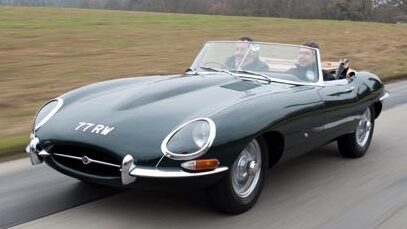Ask a car fan to vote for the greatest automotive designer of all time and the result tends to be fairly predictable.
Legendary Italian names such as Giugiaro and Pininfarina top the list, but there’s rarely a mention for the creator of the Jaguar E-Type – described by Enzo Ferrari as “the most beautiful car ever made”.
Jaguar founder Sir William Lyons often gets the credit for the design of the car, and indeed he famously introduced it to the world’s press at the 1961 Geneva Motor Show.
However, the E-Type was actually the creation of Jaguar stalwart Malcolm Sayer (1916-1970) – one of the first engineers to apply the principles of aircraft design to cars.

A pioneer of car aerodynamics, Sayer’s other cars included the C-Type, D-Type, XJ13 racing prototype and the XJS.
Le Mans victories
In the 1950s his cars enjoyed considerable sporting success, winning the Le Mans 24 Hours five times with the C-Type and all-conquering D-Type.
Sayer also designed the stunning Jaguar XJ13 in the 1960s, conceived to continue Jaguar’s winning ways at the Le Mans 24 Hours.
However, the lightweight V12-powered racing car never competed because Le Mans regulations changed and Jaguar focused on new projects.
The XJ13 had all the ingredients for Le Mans success. In fact, it set an unofficial closed lap record at Silverstone in 1967 with David Hobbs at the wheel, which stood until the McLaren F1 beat it by just 6mph in 1999.

Swinging sixties
Back on the road, it was the E-Type that set new standards in automotive design and performance when it was launched in 1961.
It’s fair to say that it caused a sensation. Costing a fraction of the price of rivals with similar performance, it was the affordable supercar and became an instant icon – remaining on sale for 14 years with sales of more than 70,000.
The E-type’s straight-six engine had powered Jaguar to its Le Mans victories in the 1950s. By 1961 (in 3.8-litre form) it produced 265bhp and 260lb ft of torque, making the car a genuine 150mph proposition and, like its XK120 predecessor, the fastest production car in the world.
At launch the E-Type cost £2,256 15s, including purchase tax and the all-important optional wire wheels.
Jaguar E-Type owners included celebrities such as George Best, Brigitte Bardot, Tony Curtis and Steve McQueen, while the sports car itself became as synonymous with the Swinging Sixties as the Beatles and the mini skirt.
Automotive aerodynamics
The sleek, bullet-like shape of the Jaguar E-type continues to be one of the most influential and imitated styling forms in sports car design.

The E-Type was one of the first large-production cars to evolve out of aerodynamic concepts, which until that point had been used only on sophisticated racing cars and aeroplanes.
Sayer approached the exterior shape first, seeing the silhouette as paramount to the car’s performance.
Scale models of the car were tested in a wind tunnel to assess its response to air resistance from various angles.
Attention to this detail produced fluid, uninterrupted lines that tapered from every angle, while the mechanics of the E-type were also based on the C and D-Type racers, including such elements as its independent front and rear suspension, rack-and-pinion steering, and disc brakes.
Also, an advanced semi-monocoque construction, borrowed from the aircraft industry, made the car lighter and faster.
Malcolm Sayer’s final car was the E-Type’s replacement – the XJS – which was launched five years after his death from a heart attack in 1970 – a month before his 54th birthday.
Even though the XJS did not enjoy the same status as the E-Type, it remained in production for 21 years (1975-1996) and 115,413 cars were produced.
Regularly voted the most iconic car ever, a Jaguar E-Type is on permanent display at the New York Museum of Modern Art alongside a caption which reads: “Sayer uniquely blended science and art to produce timeless shapes of exceptional and enduring beauty. He brought science to the art of car design; and scientifically produced works of art.”
© Words by Gareth Herincx & Images: Malcolm Sayer – credit http://www.malcolmsayer.com
William Lyons with the E-Type, Jaguar XJ13, D-Type winning Le Mans & 1961 E-Type – credit Jaguar

